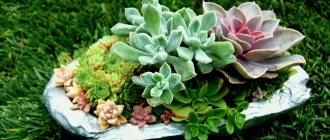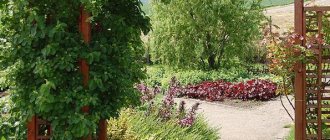Surely not all readers know what scrub roses are. And it is not surprising, because this word appeared in the everyday life of gardeners relatively recently. It denotes an entire class consisting of a group of rose varieties that share common characteristics. Simply put, this is a collection of abundantly flowering semi-climbing and shrubby varieties. They are quite multifunctional, as they are perfect for horizontal and vertical gardening.
This class includes various varieties of roses that cannot be classified into the previously identified classes. They can be different, resembling in their colors and other parameters similar to representatives of other classes and remaining unchanged only in one thing - increased bushiness. In other words, scrub roses are not a homogeneous group, which includes new varieties of different heights that do not fit into other classes and form many shoots on which flowers are formed. Abundant flowering and excellent appearance are the “calling card” of scrubs.
At first, only tall bush roses were called scrub roses, but later they were joined by semi-climbing and other new varieties, which are characterized by the formation of a large number of shoots and abundant flowering. By the way, the word Shrub came to us from the English language - it is translated as shrub, which already speaks for itself. Although all roses are shrubs, scrub roses are the bushiest of them all, hence the name. Outwardly, they are similar to the floribunda varietal group - they also bloom profusely and beautifully. And they are distinguished by the already mentioned bushiness, that is, a significantly larger number of shoots and, accordingly, flowers.
What is rose scrub
In English, this group of roses is pronounced "shrub", which means "shrub". All roses that are included in this group are shrubs. They have the following properties:
- A wide variety of flowers , ranging from ordinary tea hybrids to the floribunda group. As for the color of the “garden queens,” it also has a wide variety.
- Lush abundant flowering. Absolutely all varieties of this group begin flowering in early summer and end in autumn. Most varieties bloom repeatedly, but there are varieties that bloom once (for example, Fritz Nobis).
- Aroma. Almost all varieties have an expressive, pleasant aroma.
- Size. Roses in this category are distinguished by the height and strength of their branches and stems (some varieties can grow up to two meters in length).
- Resistance to frost and harmful insects. Scrubs easily tolerate cold and frost, needing only a little protection during cold weather, which cannot be said about many other groups of roses.
- Unpretentiousness. If you look at the description of caring for many varieties of scrub roses, you can come to the conclusion that even novice gardeners can cope with growing and caring for them.
- Possibility of combination with other groups of roses. Scrubs are suitable not only for single planting, but also for planting in groups consisting of three to five bushes.
Although scrub roses are an ideal solution for gardeners living in the colder climate of Russia and for just beginning gardeners, they still have a drawback - the need to cover the bush for the winter and regular pruning. So, rose scrub - what it is, you can see in the photo.
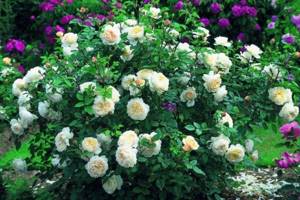
Where to plant scrubs?
Scrubs can be grown either in single plantings or in small groups (3-5 bushes), or by creating borders (especially from ground cover roses). Most scrubs do not require supports. • For tapeworms, choose plants with a beautiful bush shape and an abundance of flowering, with a pleasant aroma, for example, an excellent rose for tapeworm - Decor Arlequin. • Planting in small groups gives the effect of a blooming ball of roses; all the irregularities of one bush are hidden by the neighboring ones. The distance between bushes can be from 50 cm to more than 2 m, depending on the width of the bushes. On average per 1 sq. m, 2 to 3 bushes are planted. • Several bushes of English roses look good, planted in a triangle at a distance of 50 cm from each other, creating the effect of one large, luxuriously blooming bush. In large shrub roses, sometimes the bare part of the bush is visible, and then it can be hidden by low-growing roses located in front of them.
Scrub roses unite various modern varieties, which, according to their characteristics, should belong to groundcover, English, climbing and other roses, but due to their unusualness they are classified as scrubs. Therefore, the group is very diverse and is divided into subgroups:
- English or nostalgic roses
One of the favorite varieties that breeder David Austin has been breeding for years, dreaming of creating varieties from Bourbon, French and tea, floribunda roses that would combine the ancient beauty of the flower with modern colors and duration of flowering. The resulting scrub roses are distinguished by double flowers, colors of apricot, peach, yellow, and red. The shape of the bushes is compact and neat, they are covered with lush flowers that bloom twice a year - at the beginning and at the end of summer. The varieties have good disease resistance.
Nostalgic roses also come in:
- “Belvedere” is an excellent variety for lovers of peach shades; it looks great in group planting. The flowers are orange-peach in color, up to 12 centimeters in diameter, densely double, they practically do not fade in the sun. Flowering is long, the first wave is characterized by a large number of buds, followed by several more flowering periods with fewer flowers. The bush is powerful, a little more than a meter high, covered with dark green shiny leaves. "Belvedere" is resistant to frost, drought and disease. The variety is shown in the photo.
- "Artemis" is a vigorous and profusely flowering variety. The flowers are spherical, creamy, up to 6-7 centimeters in size, collected in brushes of 5-10 pieces. "Artemis" has a delicate, light aroma; the variety is ideal for planting in flower beds. The beauty of the bush is conveyed by the photo.
- Canadian roses
Scrub roses bred by Canadian breeders are very popular. These varieties are highly frost-resistant and are able to survive even in severe winter conditions down to -40 degrees, so in our latitudes they winter well after simple hilling, and they do not need shelter at all. There are two types of varieties in this group - Parkland and Explorer. The former are characterized by beautiful and varied shades and shapes of flowers, the latter are a climbing and fragrant branch of Canadian roses. Canadian scrub roses bloom luxuriantly and for a long time; they require simple care and minimal pruning.
"Morden Central" is the best variety of Canadian scrub rose. Terry cupped or flat flowers can reach 10 centimeters in diameter. The color when blooming is light crimson, but fades to pink in the sun. Flowers are single or collected in inflorescences of 3-7 pieces. The formation of buds occurs only on young shoots, so pruning must be strong. In autumn the bush is covered with bright red fruits. Flowering is long-lasting and includes summer and autumn waves. Trimming spent buds encourages continued flowering. The bush is erect, up to 1.2 meters high, prickly. The variety is resistant to frost and disease. An example of a plant is shown in the photo.
In the 80s of the last century, many different varieties of ground cover roses were created, which can easily be classified as a separate group, but are often classified as scrubs. These are bushes with long, delicate branches that bend and cover the ground. They bloom profusely and for a long time, and thanks to the unusual shape of the bush they create real blooming pink carpets. Also, scrub roses of this group are resistant to disease and frost. Before planting a rose of this variety, you need to find out the maximum size of an adult bush, since ground cover roses take up a lot of space.
- Scrub roses from the Bratiev Topalovich nursery
Read also: The best variety of beets
Now these varieties are grown in almost all corners of the world, achieving success in this field. For example, in Serbia there is the Bratev Topalovich nursery - one of the oldest in Europe, opened back in 1931. Every year a variety of seedlings are grown there, including scrubs. For long and painstaking work, the Bratev Topalovich nursery received various medals and prizes at international exhibitions.
The Topalovich Brothers seedlings are distinguished by their health, good resistance to frost and disease, and take root quickly. Mature bush crops from the nursery “Bratiev Topalovich” delight with large flowers with a diameter of up to 12-13 centimeters, bright colors, and lush, double forms. As a rule, the flowers of the Topalovich Brothers roses have a classic wavy shape, excellent for cutting and forming bouquets, an example can be seen in the photo. For the most part, Topalovic roses are resistant to most known pests and diseases. But some of the most exotic varieties of Topalovich roses require constant and painstaking care. Among the varieties of Topalovich scrubs, the most popular are Abra-Kadabra, Polar Bear, Black Baccarat, Blazh, Blue Nile, Cool Water, Simsabella, Fija Negro, and Black Bouquet. The seedlings of this nursery are not only of good quality, but also attract with their lush, bright flowers, unusual in color and shape.
About trimming scrubs
You need to dwell in more detail on the methods of trimming scrubs, as the most difficult stage of care. Pruning is done to shape the bush and remove weak parts to improve growth. All sampling methods are moderate and depend on the type of rose. Pruning begins after the snow melts in April or during the planting process. We select up to 5 stems, which are distinguished by their strength, on which there are up to 8 buds. It is necessary to remove weak, damaged and dead stems over the winter. And also prune the normal ones a little so that they develop better.
If the stem is more than a meter, then cut off from 40 cm to half. The side ones are also pruned to half the length or by 2/3 if they were 40 cm in size. Moderation of pruning is required because the buds in the scrubs take quite a long time to wake up compared to other roses. For this reason, the buds do not respond very well to strong shortening of the branches and may respond with weak flowering. And with a little pruning, flowering becomes more abundant and a second-order branch develops. After 5 years, rejuvenation is done, heavily pruning the old branches and 1/4 of the young ones. You can limit yourself only to pruning for sanitary purposes and rejuvenation. In autumn, young shoots, which are watery, are not cut off very short so that they do not freeze
Types and varieties
Scrub roses have received recognition from many amateur gardeners for their ease of care, frost resistance and at the same time excellent decorative qualities. For this reason, breeders are developing new, even more advanced species. Breeder David Austin received the following varieties:
- Desdemona;
- Ancent Mariner;
- Poets Life;
- Tranquility.
We will tell you more about each David Austin variety, as well as other breeding species below.
"Desdemona"
It is distinguished by peach-colored buds, which, when the flower blooms, acquire a white color with light pinkish tints. The flower is fragrant with the aroma of myrrh and has the ability to retain its bud shape even after heavy rain or strong wind.
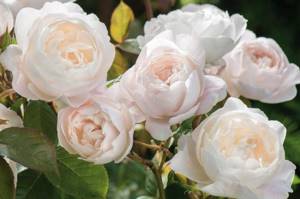
The Ancient Mariner
This rose variety has double flowers of fairly large size, bright pink color, which equally cover the entire bush. A distinctive feature of the rose is its golden-colored stamens, as well as continuous flowering until the onset of cold weather.
"The Poets Wife"
The bush of this variety has a spherical shape and bright yellow flowers that are not prone to fading. At the very beginning of flowering, a persistent lemon aroma emanates from the bud, but towards the end of flowering the aroma acquires sweetish shades.
Tranquility
The bush of this rose variety has a rounded shape and is decorated with snow-white flowers that exude an apple aroma. It has high decorative qualities, which makes the variety popular for landscaping squares and park areas.
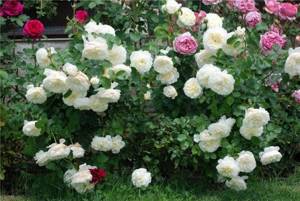
Above were the latest varieties bred by breeder David Austin. Next, we will describe the plant varieties that are most often found among experienced gardeners.
"Bonanza"
It is a long-flowering shrub, the flower petals of which have different shades: the inner part of the bud has a bright orange tint, and the outer part is pink. When the bud fully opens, in its core you can see the stamens, which have a golden color. A distinctive feature of “Bonanza” is its self-cleaning, which is manifested in the fact that the plant independently controls the number of buds and leaf cover, which makes it not require pruning.

"Belvedere"
It bears large flowers of a delicate peach color. This variety looks great in one composition with several rose bushes, i.e. in a group planting. The plant exudes a slightly tart aroma that can persist throughout the flowering period. If the shrub is provided with the necessary favorable conditions, the plant can grow up to 1.2 m in height. The rose is characterized by continuous flowering, however, the greatest amount of formation and blooming of buds occurs in the first wave, followed by a number of weaker cycles. As a disadvantage of the variety, one can highlight its strong susceptibility to various diseases, such as powdery mildew.
"Anny Duperey"
This shrub, reaching a height of one meter, has bright lemon-colored flowers that exude a light citrus aroma. It has the ability to withstand severe frosts (temperatures up to -23 degrees), as well as resistance to some diseases (black spot and powdery mildew) . Among the disadvantages of this variety is poor resistance to rain, during which the buds cannot open completely or do not open at all.
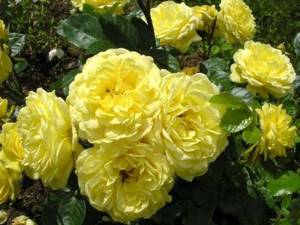
"Schneewitchen"
It is one of the earliest varieties of scrubs bred (obtained in 1985). The bush can grow up to one and a half meters in height and has good branching. The plant has small light green buds that turn into white semi-double flowers, reaching 6-7 cm in diameter. Flowering is abundant and occurs continuously throughout the growing season. A distinctive feature of the variety is its fairly strong resistance to pests and diseases - this makes the plant even more popular among beginners in gardening and floriculture.
Abraham Darby
This is a strong shrub with a rounded shape, reaching a height of one and a half meters. The buds of the plant, which have a classic shape, turn into densely double flowers of a soft pink or apricot hue. The flower has smooth shiny leaves. The rose blooms quite early and is capable of continuing continuous flowering until cold weather. It is resistant to diseases and easy to care for. The only drawback is the drooping of the flowers, due to their large size (diameter approximately 14 cm) and heavy weight. The variety is able to withstand frosty temperatures down to -29 degrees, but is poorly resistant to heavy rains, during which the buds do not open.
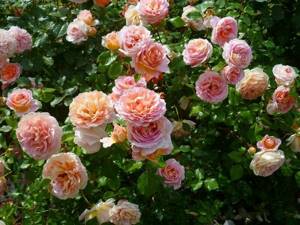
"Countess Diana"
The rose takes its name in honor of Countess Diana Bernadotte, the famous milliner and trendsetter of modern hat fashion. The flowers of this variety are fragrant with a mixture of floral and fruity aromas, with a hint of citrus scent. The flowers are densely double, have a purple-violet color, the buds are large - about 10 cm in diameter. It has long and abundant flowering. The height of Diana's rose reaches one meter. It is characterized by high resistance to frost and diseases.
"Rococo"
It is a shrub that can grow up to 1.5 meters in length. It is decorated with large (about 10 cm in diameter) flowers with an apricot tint. The flowers are collected in small clusters, have unusual double wavy petals, and are able to withstand exposure to strong winds or rain. During the entire flowering period, the buds are subject to fading, so at the final stage of flowering they take on a pearl-cream hue. The rose has a fairly high resistance to diseases such as black spot and powdery mildew.
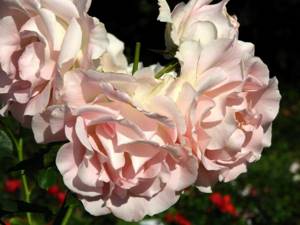
"Artemis"
This variety of rose has the ability to withstand frosts down to -23 degrees and is quite demanding in terms of care. The inflorescences look like umbrellas, consist of 5-10 creamy-white flowers, 5-8 cm in size. They are distinguished by almost continuous flowering and a rich anise aroma. The shrub needs good lighting, regular fertilizing and a drainage system. The variety looks great both when planted alone and in composition with other flowers.
"Blanc Meillandecor"
This is a low-growing variety and belongs to the ground cover group. The height of the bush varies from 30 to 50 cm, but the diameter of the flower is 10-15 cm. Each bud has about 70-80 snow-white petals. The flowering period begins in the first half of June and continues until the end of October. A distinctive property of this variety is its ability to withstand frosts down to -40 degrees. The rose is also highly resistant to fungal diseases.
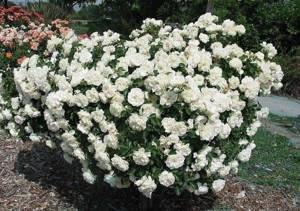
"Sapphire"
This variety reaches a height of 100-130 cm. The flowers of the Sapphire rose are double, 6-8 cm in diameter, and have a light lilac-blue color. The petals are slightly transparent. The buds exude a pleasant, soft aroma. Repeated flowering. The plant may be susceptible to a disease such as powdery mildew, however, in the event of prolonged drought.
The most popular varieties of scrub roses
The climbing climbing rose shrub has many varieties, each of which has its own advantages and benefits. For example, the classic Belvedere evokes nostalgia for antique roses similar to Austin's specimens.
It tolerates cold well and feels great in hot weather. It has large buds, up to 12 centimeters in diameter, soft peach color, resistant to fading. The height of the bush is up to a meter, the foliage is dense green, shiny, flowering is abundant and continuous.
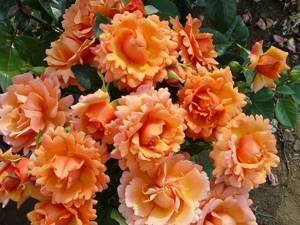
Rose Artemis is a well-known representative of the scrub family and belongs to the English flowers. Modest flowers of small size (from six to seven centimeters) emit a delicate and pleasant aroma, and their color is coffee or creamy. The compact bush will be an ideal decoration for any flower bed.
Canadian scrub Centennial Morden is distinguished by large raspberry-colored buds. Their diameter can reach ten centimeters. Due to the fact that its beautiful ovaries are formed exclusively on young branches, the variety must be pruned regularly. In autumn, Centennial Morden becomes rose hip-like, producing large red fruits. It is very beautiful and effective, with the only drawback: it can be overly prickly.
Bonanza is an orange rose with a red border on the edges of the buds. The petals can have yellow and red shades, and when dissolved, the flower reaches eight centimeters. A characteristic feature is stamens with a large amount of pollen. The light and pleasant aroma and repeated flowering in the summer season are the undeniable advantage of Bonanza, and its resistance to disease and cold has long made it a favorite of Russian gardeners. The height of the bush is less than two meters, it is spreading, up to a meter wide.
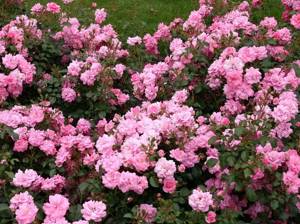
Snow ballet is a variety with double white flowers, which often have a green tint. The buds are small, about six centimeters each. It blooms in clusters, lushly and for a long time, the aroma is subtle, with light floral notes.
Growing scrub roses in the garden is an interesting and exciting activity that will be an excellent practice for those who are just trying their hand at floriculture. If you follow the necessary rules and provide the shrubs with regular care, they will delight you with continuous flowering and unique beauty from year to year.
All about scrubs, rose scrubs:
Features of planting in the ground
It is better to buy grafted seedlings in the autumn. After purchasing, the roots must be wrapped in moss or peat and wrapped in cellophane, storing the seedlings in a cool place until spring. Alternatively, they can be buried in a box of soil. To grow shrubs, you must follow some rules.
- Correct landing place. Such a site is a well-lit area, not blown by winds. The southern part of the garden area is ideal. It should be planted on loamy soil with neutral characteristics. Organic fertilizers must be added to the soil. Groundwater should lie at an average depth.
- Soil preparation. The soil must be thoroughly cleaned of debris, weeds, and stones. A couple of weeks before planting seedlings, you need to dig up the soil. And the day before planting, you should dig holes. Add one kilogram of rotted mullein and rotted compost to each hole.
- Disembarkation time. This factor is influenced by the different climatic conditions in which the rose is going to be planted. For example, in the southern zones, scrubs are planted in the first half of autumn. Thus, they will have time to take root before the onset of cold weather. In temperate climate zones, roses are usually planted in the spring.
- Landing algorithm. The seedling must be placed in a vase with water so that its root and stem are immersed 5 cm in water. Leave the seedling in the vase for 10-20 hours.
- Fertilizers must be applied to the intended planting site.
- Then dig a hole 60 cm deep.
- After a while, soil should be poured into the planting hole in a heap, and then warm water, at a temperature of approximately 16-21 degrees, should be poured into it, along with a humate solution. Then seedlings are planted there, straightening their root system.
- You should manually fill the young plant and shake the bush at short intervals. The soil should be compacted.
- Finally, the bush is darkened with spruce branches for a week.
Note! If you plant scrub roses in groups, do not forget to maintain a distance of 0.5-2 meters between them. It all depends on the volume of the bush.
Growing a flower
Landing
Before planting, it is important to choose the right seedlings. Preference should be given to annual plants with a healthy root system without damage and even, good shoots. The bark should be free of lignification and not overdried. When the root system is slightly dried, it is necessary to soak it in a vessel with water a day before planting.
The place for planting seedlings directly depends on the selected variety. If the flowers are not prone to fading, the bushes are planted in areas with good lighting. If they are prone to fading, the bushes are planted in areas protected from direct sunlight.
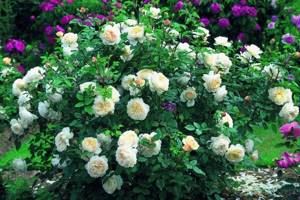
Depending on the size of the adult plant, bushes are planted at distances sufficient for full development. Volumetric plants are planted with intervals between bushes of up to 1.5-2 meters. Tall plants lose the leaf cover of the lower part of the trunks with age, so you need to plant low varieties next to them that will cover the empty trunks. Smaller varieties are planted with distances between bushes of about 50 centimeters.
Landing place
Preparing the planting site involves pre-fertilizing the soil 2 weeks before planting. Fertilizer is made with peat or compost. The pits are made 0.5 meters wide and long and 50-60 centimeters deep. A mixture of soil and fertilizer is placed at the bottom of the hole and watered well. Then a seedling is placed in the middle of the hole and buried in soil, compacting it slightly. After the seedlings are planted, the soil around is watered abundantly and mulched with sawdust.
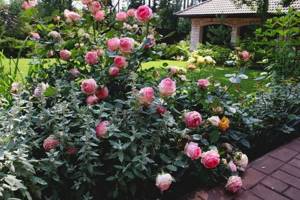
The optimal time for planting scrub rose seedlings is considered to be the end of spring or the beginning of autumn, when the soil is at least +10℃.
Growing scrub roses does not require special knowledge or much care, so it is suitable even for amateur gardeners. Most varieties do not require special conditions. Care means timely watering, pruning bushes and protection from winter cold.
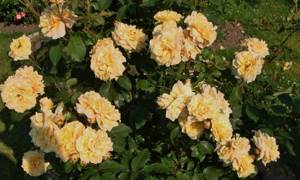
Watering and fertilizing
These hybrids do not require frequent watering, but should be watered deeply as needed. Frequent watering with a small volume of water should not be done, because the plants may begin to wither.
In areas with a hot and dry climate, bushes are watered once a week; in less warm regions, watering is done no more than once every 10 days. The best time to water is early morning or late evening, after sunset.
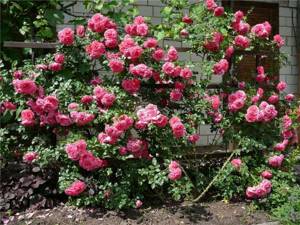
Fertilizing is done with mineral and organic fertilizers. For good growth and development of rose bushes, they need potassium, calcium and phosphorus.
Trimming
Most varieties require constant pruning. This is done in order to give shape to the bushes, as well as to rejuvenate it. Before covering the bushes for the winter at the end of autumn, they need to be pruned. Then young, immature shoots are removed; they contain a lot of moisture; in winter, at sub-zero temperatures, the moisture can turn into ice.
All foliage, buds, and branches with damage and signs of disease are also pruned. If they are not removed, rotting may begin, which provokes the development of fungal diseases.
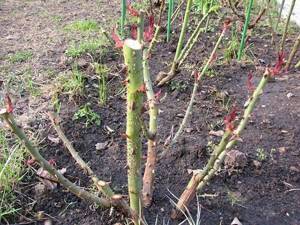
Spring pruning is done after removing the protective material. Then the dead branches are removed, leaving only those branches with a large number of buds. The main stems need to be shortened by a quarter, the side shoots should be shortened by a third.
Low-growing straight-growing varieties are shortened by half. When pruning, it is important to leave at least 8 buds on each shoot. Once every three years, the bushes are rejuvenated by removing old shoots.
Preparing for winter
Many varieties have high, good resistance to frost, and they are still covered for the winter. In the southern regions, they only insulate the soil around the bushes with an additional layer of earth and sawdust. In temperate climates, rose stems are bent to the ground and then covered with spruce branches or dry foliage.
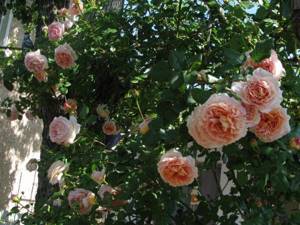
In regions with lower winter temperatures, special plant protection materials are used on top of the plant protective layer. In the spring, when the snow melts, it is important to remove the protective material in time, otherwise the plants may begin to rot, and then they may become more vulnerable to infections.
Rose care
Despite the fact that scrubs are considered a fairly unpretentious plant, the shrub must be pruned, watered, fertilized, covered for the winter, etc. in a timely manner.
- Watering. This group of roses prefers to grow in moist soil, but it does not tolerate stagnant water. Watering should be done once every 7 days. It is important that moisture does not fall on the foliage, otherwise they may be affected by fungal diseases. If watered incorrectly, the rose sprouts will be low and there will be a small number of flowers. After watering is completed, the soil must be loosened and the bushes hilled.
- Fertilizer. To prevent excessive evaporation of moisture, the soil can be mulched with compost or peat. In the spring, when the first shoots appear, nitrogen is added. In summer, potassium and phosphorus are added for active flowering and growth.
- Trimming. It is obligatory in spring: it is worth cutting off already dry branches, as well as some of the shoots for more intensive growth. It is necessary to cut the stems with pruning shears at an angle of 45 degrees. If a diseased shoot is discovered, it should be removed down to the healthy part. In the summer, you need to remove faded buds or part of them. This is done so that the next flowers will be larger.
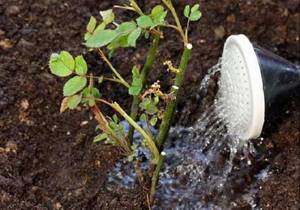
Use in landscape design
Scrub roses are planted in the center of the flower bed, against the background of the lawn or in another prominent place. They look spectacular along borders or in a group of five long-flowering bushes. Flowering scrubs are also used to form balls called fountain roses. Separately planted, rather large bushes can be planted on the sides with low-growing and less spreading varieties.
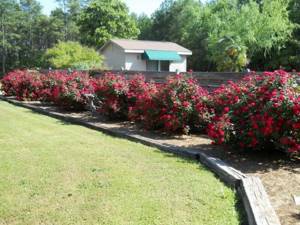
Ground cover scrubs are often planted next to rocks or on rocky slopes. They are used for planting in a wide variety of places: directly in the garden, on balconies, verandas. Often they are formed into trunks in the form of cascades that hang from the trunk or create “pink carpets”. Thus, scrubs will help to green the garden plot both vertically and horizontally.
Similar articles:
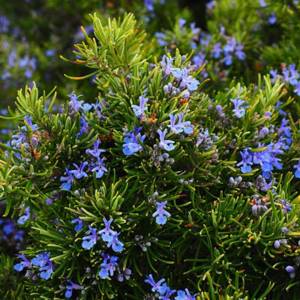
Rosemary: description of the plant with photos, popular types...
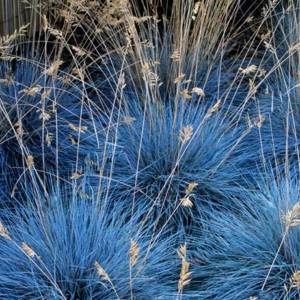
Features of planting and caring for gray fescue,…
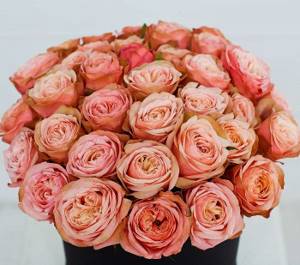
Types of hybrid tea and peony roses



